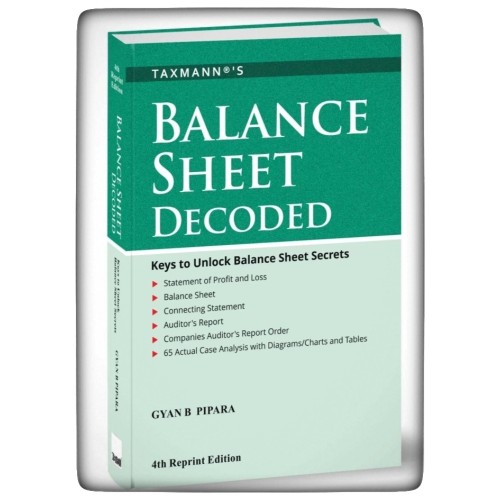Balance Sheet Decoded – Keys to Unlock Balance Sheet Secrets Gyan B. Pipara
Description
This book aims to explain how to read, analyse and interlink the voluminous information available in the financial statement with the help of charts, case analysis, etc. In other words, this book provides an in-depth analysis, a stepwise approach using case analysis, to understand & decode the financial statements.
This book will be helpful to anyone analysing based on financial statements, i.e., bankers, CFOs, auditors, analysts, researchers, investigators, regulators, etc.
This book extensively deals with the following issues & suggests how they can be mitigated through proper analysis of financial statements:
- Laxity in credit risk appraisal and loan monitoring in banks
- Lack of appraisal skills for projects that need specialised skills, resulting in acceptance of inflated costs and aggressive projections
- Wilful default, loan fraud and corruption
This book has been divided into five parts:
- Statement of Profit & Loss
- Balance Sheet
- Connecting Statement
- Concept of Audit and Auditor's Report
- Master Key
The Present Publication is the 4th Edition and has been updated till 31st January 2023. This book is authored by Gyan B. Pipara, with the following noteworthy features:
- [Reading Between the Lines of Financial Statements] and correlating relevant information with proper analysis, using the Author's experience of 40+ years
- [How to Hone your Skills to Dissect Financial Statements] with surgical precision
- [Unlocking the Mysteries & Tricks] by explaining how to analyse the various details & detect what has been disclosed or not
- [Focused Analysis] to find out strengths, early warning signs, frauds, creative accounting, genuineness of various items, etc.
- How to read the balance sheet beyond what is visible on the surface
- How to analyse the information
- How to correlate the various details available
- [Professional Oriented Book] This book has been developed keeping in mind the following factors:
- Interaction of the author during his training with various banks and organisations on credit and analysis of the financial statement
- Shaped by the authors' experience of 40+ years being a chartered accountant, research analyst and fraud investigator
- Reactions and responses of attendees during the training have also been incorporated at different places in the book
- [New Chapter on CARO 2020] has been considered in detail under Key #4 – The Companies Auditor's Report Order
- [Updated & Amended] All changes made in the Companies Act and latest position as of the end of January 2023 have been considered in this book
The structure of the book is as follows:
- What is it?
- Under this part, the nature of the item is explained so that it becomes easy to analyse
- Do you Know?
- Under this part, the important integral requirement of the Companies Act, Indian Accounting Standards or any other law relating to such point is highlighted. The objective of providing the information is that sometimes it is found that the management and auditor are overlooking the requirement. Without such knowledge, the analysis may not be complete; therefore, the same is provided under this heading.
- Why is it Important?
- Under this heading, the item's importance is explained for financial statement analysis to unlock the secrets. This part explains why it is relevant and how it is relevant to find out any important issue relating to such items, which may lead to early warning signs, red flags, strengths or weakness
- How to Analyse to Unlock?
- This is the most crucial part of the relevant chapter. Under this heading, a stepwise approach is explained for optimum item analysis. As each item of the balance sheet and statement of profit and loss serves a different purpose, separate methodologies and approaches have been used for analysing the items considering their natures. Therefore, for analysis (one which is result-oriented and objective), a separate methodology has been designed considering the nature of the chapter
- Case Analysis
- After explaining the meaning of the item (what is it), the integral points (do you know), the importance of the item (why is it important), the method and approach of analysis (how to analyse to unlock), a real case analysis is picked, which best explains the issue. In the case of analysis, only that part of the financial statements relevant to the issue under the chapter is provided in the box. Sometimes, considering the importance of the chapter, more than one case analysis is also used, apart from the use of research/study. Therefore, whatever information is provided in the box is actual and real, as available in the balance sheet of the case analysis. After providing the actual information in the box, the same is explained for a logical conclusion of the issue
- Bottom Line
- It is the concluding part of the chapter, wherein the issue is summarised in short
The detailed contents of the book are as follows:
- Statement of Profit & Loss
- Revenue from Operations
- Other Income
- Cost of Materials Consumed and Purchases of Traded Goods
- Manufacturing and Operating Cost
- Finance Cost
- Depreciation
- Tax Expense
- Other Expenses
- Exceptional Items, Extraordinary Items and Prior Period Items
- Property, Plant and Equipment – Tangible
- Fixed Assets – Intangible
- Investments
- Loans & Advances
- Other Assets
- Inventories and Trade Receivables
- Cash, Cash Equivalent and Bank Balances
- Advances Recoverable in Cash or Kind or for Value to be Received
- Shareholders' Funds or Net Worth or Capital
- Provisions & Contingent Liabilities
- Borrowings
- Trade Payables and Other Liabilities
- Connecting Statement
- Significant Accounting Policies
- Notes on Accounts
- Cash Flow Statements
- Concept of Audit and Auditor's Report
- Understand the Concept of Audit
- Report on Internal Financial Controls
- Analysis of Auditors' Opinions
- Analysis of Emphasis of Matters/Note
- Companies Auditor's Report Order
- Control over Resources
- Related Party Transactions
- Legal Compliance
- Non-Banking Finance Companies
- Statutory Dues
- Financial Health of the Company
- End Use of Funds
- Frauds and Unrecorded Transactions
- Resignation of Statutory Auditor
- Master Key
- How to Link 5 Keys to Decode Financial Statement
- Key #1 – Items of Profit and Loss
- Key #2 – Items of Balance Sheet
- Key #3 – Importance of the Notes on Accounts, Significance of Accounting Policies and Inconsistencies in Disclosures & Actual Practice
- Key #4 – Auditors Report & CARO Report
- Key #5 – Linking the above Keys to have an effective result
This book aims to explain how to read, analyse and interlink the voluminous information available in the financial statement with the help of charts, case analysis, etc. In other words, this book provides an in-depth analysis, a stepwise approach using case analysis, to understand & decode the financial statements.
This book will be helpful to anyone analysing based on financial statements, i.e., bankers, CFOs, auditors, analysts, researchers, investigators, regulators, etc.
This book extensively deals with the following issues & suggests how they can be mitigated through proper analysis of financial statements:
- Laxity in credit risk appraisal and loan monitoring in banks
- Lack of appraisal skills for projects that need specialised skills, resulting in acceptance of inflated costs and aggressive projections
- Wilful default, loan fraud and corruption
This book has been divided into five parts:
- Statement of Profit & Loss
- Balance Sheet
- Connecting Statement
- Concept of Audit and Auditor's Report
- Master Key
The Present Publication is the 4th Edition and has been updated till 31st January 2023. This book is authored by Gyan B. Pipara, with the following noteworthy features:
- [Reading Between the Lines of Financial Statements] and correlating relevant information with proper analysis, using the Author's experience of 40+ years
- [How to Hone your Skills to Dissect Financial Statements] with surgical precision
- [Unlocking the Mysteries & Tricks] by explaining how to analyse the various details & detect what has been disclosed or not
- [Focused Analysis] to find out strengths, early warning signs, frauds, creative accounting, genuineness of various items, etc.
- How to read the balance sheet beyond what is visible on the surface
- How to analyse the information
- How to correlate the various details available
- [Professional Oriented Book] This book has been developed keeping in mind the following factors:
- Interaction of the author during his training with various banks and organisations on credit and analysis of the financial statement
- Shaped by the authors' experience of 40+ years being a chartered accountant, research analyst and fraud investigator
- Reactions and responses of attendees during the training have also been incorporated at different places in the book
- [New Chapter on CARO 2020] has been considered in detail under Key #4 – The Companies Auditor's Report Order
- [Updated & Amended] All changes made in the Companies Act and latest position as of the end of January 2023 have been considered in this book
The structure of the book is as follows:
- What is it?
- Under this part, the nature of the item is explained so that it becomes easy to analyse
- Do you Know?
- Under this part, the important integral requirement of the Companies Act, Indian Accounting Standards or any other law relating to such point is highlighted. The objective of providing the information is that sometimes it is found that the management and auditor are overlooking the requirement. Without such knowledge, the analysis may not be complete; therefore, the same is provided under this heading.
- Why is it Important?
- Under this heading, the item's importance is explained for financial statement analysis to unlock the secrets. This part explains why it is relevant and how it is relevant to find out any important issue relating to such items, which may lead to early warning signs, red flags, strengths or weakness
- How to Analyse to Unlock?
- This is the most crucial part of the relevant chapter. Under this heading, a stepwise approach is explained for optimum item analysis. As each item of the balance sheet and statement of profit and loss serves a different purpose, separate methodologies and approaches have been used for analysing the items considering their natures. Therefore, for analysis (one which is result-oriented and objective), a separate methodology has been designed considering the nature of the chapter
- Case Analysis
- After explaining the meaning of the item (what is it), the integral points (do you know), the importance of the item (why is it important), the method and approach of analysis (how to analyse to unlock), a real case analysis is picked, which best explains the issue. In the case of analysis, only that part of the financial statements relevant to the issue under the chapter is provided in the box. Sometimes, considering the importance of the chapter, more than one case analysis is also used, apart from the use of research/study. Therefore, whatever information is provided in the box is actual and real, as available in the balance sheet of the case analysis. After providing the actual information in the box, the same is explained for a logical conclusion of the issue
- Bottom Line
- It is the concluding part of the chapter, wherein the issue is summarised in short
The detailed contents of the book are as follows:
- Statement of Profit & Loss
- Revenue from Operations
- Other Income
- Cost of Materials Consumed and Purchases of Traded Goods
- Manufacturing and Operating Cost
- Finance Cost
- Depreciation
- Tax Expense
- Other Expenses
- Exceptional Items, Extraordinary Items and Prior Period Items
- Property, Plant and Equipment – Tangible
- Fixed Assets – Intangible
- Investments
- Loans & Advances
- Other Assets
- Inventories and Trade Receivables
- Cash, Cash Equivalent and Bank Balances
- Advances Recoverable in Cash or Kind or for Value to be Received
- Shareholders' Funds or Net Worth or Capital
- Provisions & Contingent Liabilities
- Borrowings
- Trade Payables and Other Liabilities
- Connecting Statement
- Significant Accounting Policies
- Notes on Accounts
- Cash Flow Statements
- Concept of Audit and Auditor's Report
- Understand the Concept of Audit
- Report on Internal Financial Controls
- Analysis of Auditors' Opinions
- Analysis of Emphasis of Matters/Note
- Companies Auditor's Report Order
- Control over Resources
- Related Party Transactions
- Legal Compliance
- Non-Banking Finance Companies
- Statutory Dues
- Financial Health of the Company
- End Use of Funds
- Frauds and Unrecorded Transactions
- Resignation of Statutory Auditor
- Master Key
- How to Link 5 Keys to Decode Financial Statement
- Key #1 – Items of Profit and Loss
- Key #2 – Items of Balance Sheet
- Key #3 – Importance of the Notes on Accounts, Significance of Accounting Policies and Inconsistencies in Disclosures & Actual Practice
- Key #4 – Auditors Report & CARO Report
- Key #5 – Linking the above Keys to have an effective result




